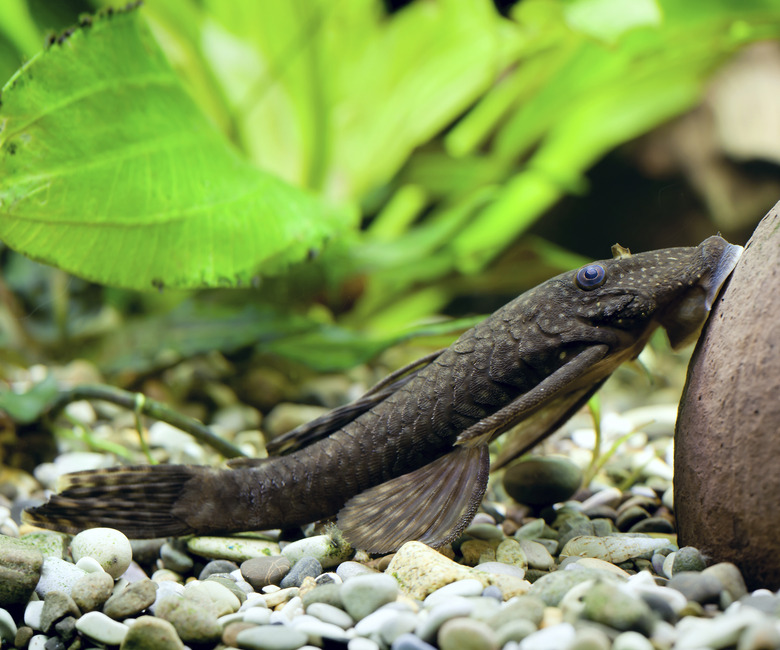Care Of Sucker Fish
The sucker fish, also known as a plecostomus (pleh-KOS-toe-muss) or "common pleco," is a valuable resident in any fish tank. Fish tank sucker fish eat discarded food from the bottom of the tank and clean bits of algae off tank surfaces. Their generally low-key personalities make them compatible with all but the most aggressive tank mates.
A suitable home
A suitable home
Sucker fish like a well-decorated tank. Although they may interact with other fish in the tank, a pleco is most comfortable with plenty of places to hide. Intricate ceramic aquarium decorations that tend to collect algae are practical if you have an algae sucker fish in the tank; he'll keep them polished.
A tank that receives natural sunlight through a window for part of the day and consequently grows algae will supply the sucker fish's need for fresh greenery and also give him a chance to bask for short periods of time. Add at least one piece of driftwood to the tank; algae sucker fish like to chew on wood with the rasp-like teeth that surround their mouths.
Plecos are messy fish that excrete a lot of urine and feces. Make sure your filtration system is up to handling the extra load. Plecos don't eat poop; they only make it. Most plecos in the wild hail from soft, alkaline waters. Keeping them in a tank of fish requiring hard water such as cichlids will challenge their ability to survive.
The right food
The right food
Although a sucker fish for the aquarium will eat green algae from the tank as well as flakes of food you add for his tank mates, he also needs supplementary food and regular treats of fresh veggies. A clean romaine lettuce leaf planted in the gravel will attract all the fish; plecos also like fresh or frozen (thawed) peas, bits of cucumber, and partially cooked zucchini.
It is a myth that Drop in an occasional commercial algae disk at night, when the other fish aren't feeding, to be sure the nocturnal pleco gets enough greens. Your algae sucker fish should also have a piece of wood to gnaw on.
Choose the best plecos
Choose the best plecos
Make sure you choose the best plecos for your tank size, fish-keeping goals, and water chemistry. For example, the common pleco can grow up to 20 inches in length, and he'll outgrow that 10-gallon hobby aquarium if you take good care of him. He'll also likely outlive your child's (or your) interest in aquarium keeping at a lifespan of 10 to 15 years.
Smaller types of suckerfish for aquariums include bristlenose plecos and otoclinus. For other plecos, 30 or more gallons is advisable, and you will want to plan for a 100-gallon tank to house a full-grown common pleco. Purchase an active sucker fish that has a level or plump (not hollow-looking) belly. This tells you that the fish is eating well and is healthy. Plecos are reclusive and generally nocturnal, so don't judge a fish by its activity level.
Keep them safe
Keep them safe
Leave an inch or two of air space at the top of the tank; sucker fish will occasionally swallow air to control their buoyancy. But leave the lid on the tank; they can leap short distances. If you find your sucker fish has jumped the tank, place him back in the water to recover; they can live short periods of time without water.
Plecos are often ignored by their tank mates, but occasionally an aggressive fish will bully a sucker fish. Keep fish of similar size together to avoid predation or bullying. Although they're calm and mostly vegetarian, a foot-long pleco won't blink an eye as it chases and swallows any fish that will fit in its mouth.
Have a plan to find him a new home if he ends up being unsuited to your aquarium, such as passing him on to a fellow fish keeper, giving him a tank of his own, or selling him. Plecos released into natural waterways can devastate an environment through undercutting banks and eliminating food sources needed by native species. Never flush him down the toilet as chemicals and gasses will cause him to suffer; humanely dispatch a fish as a last resort through a euthanasia bath or decapitation.

